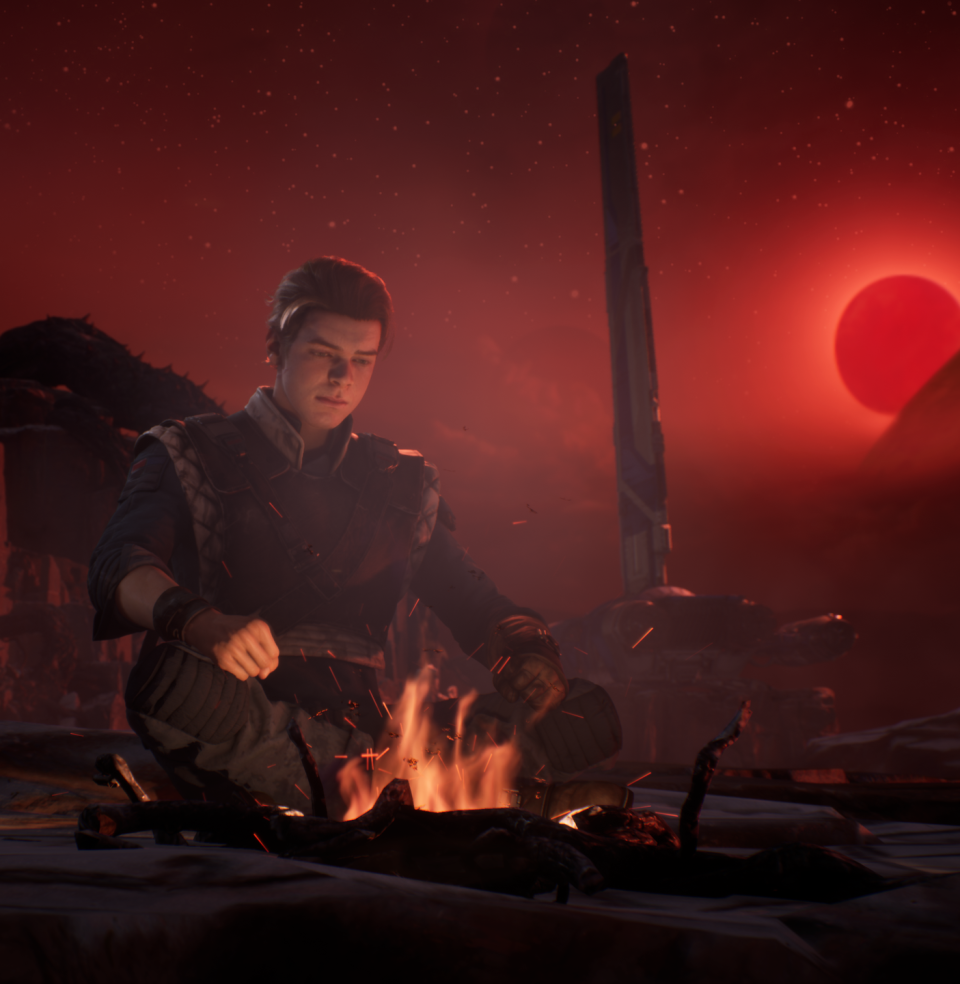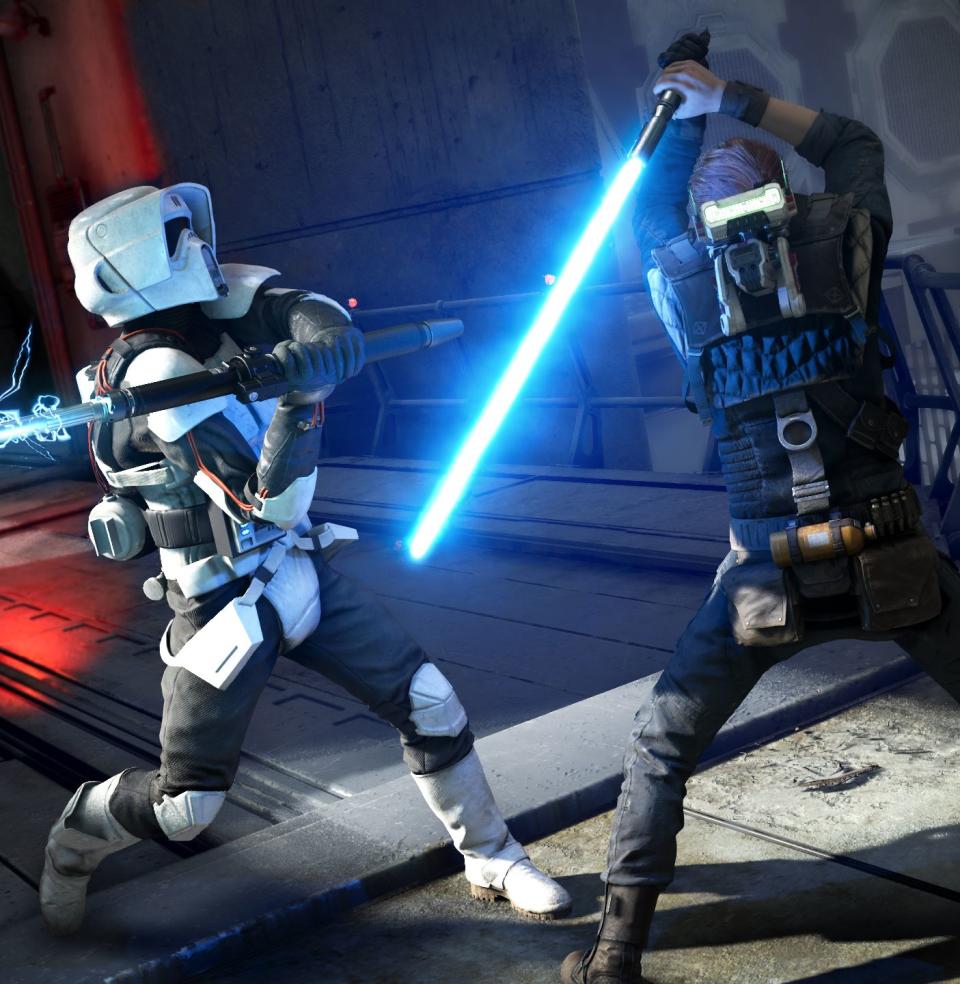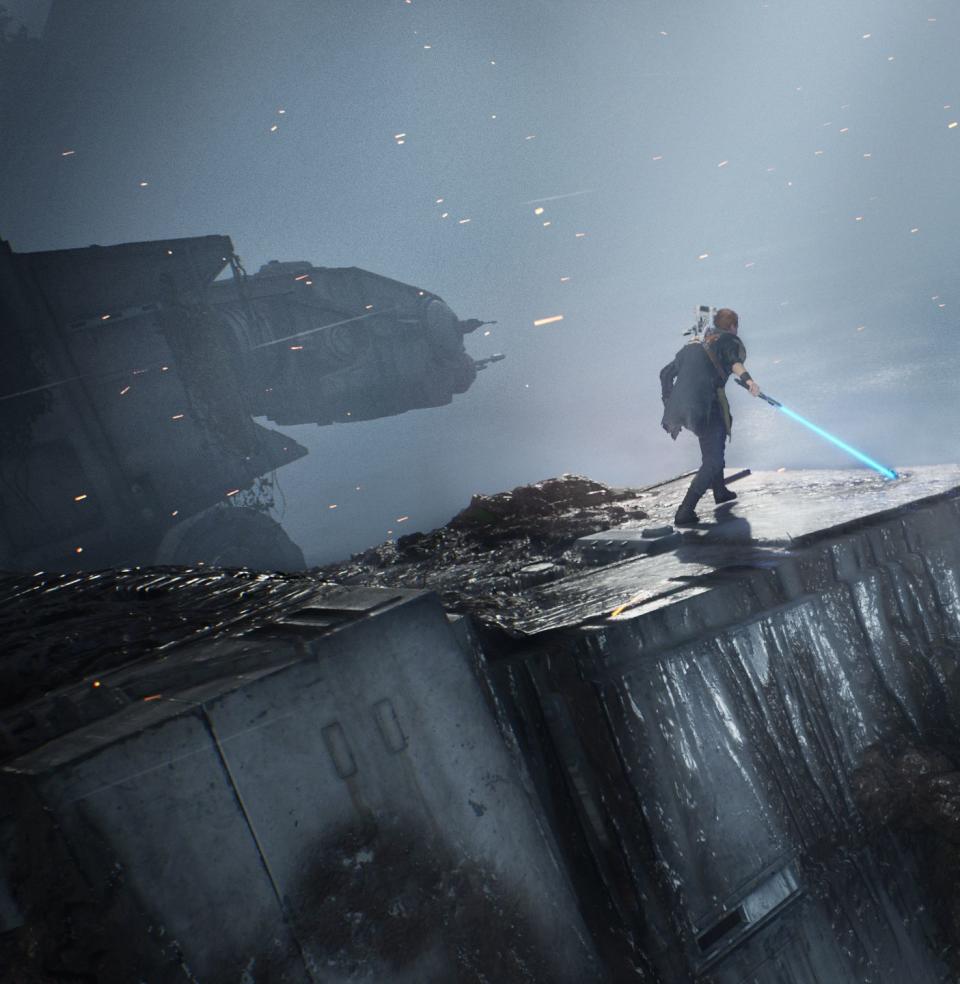'Star Wars Jedi: Fallen Order' Is a Game You Will Fail. And Fail. And Fail.
“Failure is not the end.” That’s the big line uttered late in Star Wars Jedi: Fallen Order by Eno Cordova, a slain master of the ancient Jedi Order who appears in holographic displays throughout Respawn Entertainment’s new game. Though your hero faces death, though the Jedi religion has been all but eradicated, though hope for the Republic may seem completely lost, Cordova believes that the path of the Jedi is far from over.
And fail you absolutely will in Fallen Order, the most difficult Star Wars game in the franchise’s history. You’ll fail. You’ll die. And then you’ll die again. Fans are right to point out that the game looks just like Dark Souls. It might as well have been made by FromSoftware, the studio behind the infamously difficult catalog of titles that includes Bloodborne, the Souls series, and most recently, Sekiro: Shadows Die Twice. For admirers of those super-challenging games, Fallen Order is a dream come true. But for anyone else, the title is less a welcome entry into that fresh hell of elevated video game difficulty, and more a tedious, unrelenting experience that scarcely rewards the player for their hard work. That is, until you’re about 10 hours into the story, when things suddenly pick up, and you’re ripping enemies apart like Darth Vader at the end of Rogue One. Congrats, masochists. You finally have your very own Star Wars game.
Fallen Order kicks off with an impressively emotional sequence in an Imperial refinery. We meet Cal Kestis, who, from the very start, feels as human and earthy as any lead character in the series’ history. Cal’s played by Cameron Monaghan, and Monaghan delivers a motion-capture performance that is right on par with Christopher Judge and Sunny Suljic, the father and son duo from the recent God of War. Except, in Fallen Order, Monaghan gets the benefit of portraying both the adult and the child—he plays the younger version of Cal in the game’s flashback vignettes, which are among the most affecting moments of the narrative’s tragic arc.
Like Luke, Anakin, or Rey, Cal’s origins are humble. Once a promising young Padawan in the Republic, Cal managed to survive Darth Sidious’s purge of the Jedi Order by concealing his identity and taking on a menial laborer job for the Empire. He has, like Luke in The Last Jedi, cut himself off from the Force. That is, until a fellow worker at the refinery is nearly killed on the job. In a split-second decision, Cal decides to risk his own life to save his friend. Demonstrating his inherent goodness, Cal uses the Force, thus revealing himself to the Empire and setting in motion a harrowing cat-and-mouse chase that will have players blasting through hyperspace to planets all over the galaxy. It’s a legitimately moving moment for a franchise that, now more than ever, seems to be running out of ideas.

But while the narrative of Fallen Order begins with promise, it unfortunately becomes an amorphous slog quite quickly. After the thrilling stakes of the opening train escape sequence, Cal teams up with two anti-Empire agents, both of which feel unmotivated in their characterization. The pilot, Greez, is the token scruffy nerfherder smuggler dude who we’re constantly told is goofy and fun by the other characters—but we don’t really get to see any of his wacky antics ourselves. The other is a former Jedi named Cere, a woman who has given up her Jedi past due to a traumatic loss—but since Cal is Fallen Order’s only active character (the crew always conveniently has a reason to hang back in the ship while Cal goes out on missions), Cere rarely becomes more than just a void of story exposition in the game.
Cere and Greez are seeking an ancient device that is said to be capable of revealing all the known Jedi in the galaxy. With the help of this “Holocron,” the crew believes the Jedi Order could be reinstated. Now, with Cal aboard, they finally have a warrior capable of fighting his way through the thicket of Imperial defenses to locate this elusive Jedi-powered Find-My-iPhone. But right as they ship off to the game’s first planetary mission, the narrative propulsion deteriorates almost immediately. Each planet you visit serves a series of misdirections to the main goal of finding this Holocron. You’ll be facing off against a gang of giant spiders, navigating toward some mysterious ancient Jedi lair, tasked with finding some device that will reveal some key that will lead to some door—all the while asking yourself, “What the hell am I even doing anymore?”

Each time you get back to the ship, there’s a cutscene that delivers yet another laundry list of misdirections as to why the sacred Holocron cannot be reached. Coupled with the at-times infuriating difficulty of even the most basic tasks on the story missions—like trying to use a single health stim while getting attacked by more than one enemy with a range weapon—the game begins to feel like some sort of perverse Super Mario Bros., where instead of Toad, it’s Cere saying, “Thank you Cal, but the Holocron is on another planet.”
Whereas other lightsaber games have empowered players to feel like soaring warrior gods, Fallen Order is obsessed with maintaining the Jedi experience at the ground level. This feels refreshing at times, especially since nothing is less gratifying than being invincible in a video game, but Respawn’s commitment to difficulty feels just unnecessary. Ledge jumps are not easy to land. Enemy fire is consistently unpredictable. The boss battles need to be played upwards of three times, sometimes maybe even a dozen times, to complete. And even planetary fauna, which in any other game would feel like inconsequential set decoration, will absolutely ravage your health bar.
Like Dark Souls, sword fighting is based on attacking, blocking, parrying, and dodging. Each enemy has a unique set of attacks and a pattern you have to learn in order to defeat them. No two classes of enemies function the same, and when more than one type of enemy is paired with each other, you’re going to have to learn a new strategy to take them all down in tandem.
When I got a chance to play Fallen Order in an early demo and speak with Respawn Director Stig Asmussen, I wrote that the swordplay was the best lightsaber combat in Star Wars video game history, so it feels odd to criticize it now, after having enjoyed it so much before. This is undoubtedly the most elevated, thoughtful combat system to ever find itself in a Star Wars game. It's an exciting thing to experience for the first time. But plowing through hours of arduous gameplay left a different taste in my mouth.
The gameplay itself functions almost identically to Dark Souls, too. After you die, you have to go out and find the enemy who killed you, strike them, and then you can recollect the health and experience points you dropped. There is no auto-save. Save points are scattered throughout the levels, which offer you the option of saving, upgrading your skills, or a peculiar “rest” function, which restores your health but also respawns all of the enemies on the field. These save points quickly become hugely significant for your mental wellbeing during gameplay. And when I say they’re scattered throughout the levels, I really mean scattered. You may lose 20 minutes of bug-killing and slug-dodging just because the developers decided to place a save point just a platform or two out of reach. Why not just let people auto-save?

After you manage to complete a mission deep into a planet, the game tasks you with backtracking all the way through the planet to find your ship. You’ll face all the same enemies again and be forced to overcome all the obstacles that you’d spent so much time completing already. It’s exhausting development choices like this that make the elevated combat of the game feel unrewarding, and, at-times, simply unplayable.
As you can probably tell, I’m not a big fan of Dark Souls, but that’s not to say I shy away from a challenge. I just anticipate the super-challenging sequences to come toward the back end of the game. Learning the toolkit of Mario Odyssey, refining my jumps and triple-jumps throughout the main campaign, and then putting my mastery to the test in the post-game content felt like a natural and rewarding way to experience the title. And anyone—FromSoftware fans included—who spent the time to complete that Darker Side of the Moon mission in Odyssey can agree, that shit was hard as hell. So it’s a bit of a leap for me to wrap my head around a game that not only starts on the Darker Side of the Moon stuff, but also stays there, and gets even darker as the story goes on.
Fallen Order does, however, find its footing later in the game. After 10 or so hours, Cal is granted some big new abilities—and fans are treated to some big surprises, too. When I reached that point, a lot of the hard work started to pay off. As Cal uncovers the mysteries of his past and really comes into his own as a Jedi, Fallen Order, too, comes into its own as the single-player Star Wars experience we've been waiting for. The game had lofty expectations to nail after the huge disappointments of the microtransaction-riddled EA Battlefront games, and I started to feel those expectations fulfilled towards the end. But that was a lot of hours of my life. A lot of clenched jaws, furrowed brows, and angry yelling at the screen. Maybe that’s what you want from a video game. For me, by the big finale, I wasn't sure all that effort was worth my time.
You Might Also Like

